NVIDIA’s GeForce GTX Titan Review, Part 2: Titan's Performance Unveiled
by Ryan Smith & Rahul Garg on February 21, 2013 9:00 AM ESTPower, Temperature, & Noise
Last but certainly not least, we have our obligatory look at power, temperature, and noise. Next to price and performance of course, these are some of the most important aspects of a GPU, due in large part to the impact of noise. All things considered, a loud card is undesirable unless there’s a sufficiently good reason to ignore the noise.
It’s for that reason that GPU manufacturers also seek to keep power usage down, and under normal circumstances there’s a pretty clear relationship between power consumption, heat generated, and the amount of noise the fans will generate to remove that heat. At the same time however this is an area that NVIDIA is focusing on for Titan, as a premium product means they can use premium materials, going above and beyond what more traditional plastic cards can do for noise dampening.
| GeForce GTX Titan Voltages | ||||
| Titan Max Boost | Titan Base | Titan Idle | ||
| 1.1625v | 1.012v | 0.875v | ||
Stopping quickly to take a look at voltages, Titan’s peak stock voltage is at 1.162v, which correlates to its highest speed bin of 992MHz. As the clockspeeds go farther down these voltages drop, to a load low of 0.95v at 744MHz. This ends up being a bit less than the GTX 680 and most other desktop Kepler cards, which go up just a bit higher to 1.175v. Since NVIDIA is classifying 1.175v as an “overvoltage” on Titan, it looks like GK110 isn’t going to be quite as tolerant of voltages as GK104 was.
| GeForce GTX Titan Average Clockspeeds | |||
| Max Boost Clock | 992MHz | ||
| DiRT:S | 992MHz | ||
| Shogun 2 | 966MHz | ||
| Hitman | 992MHz | ||
| Sleeping Dogs | 966MHz | ||
| Crysis | 992MHz | ||
| Far Cry 3 | 979MHz | ||
| Battlefield 3 | 992MHz | ||
| Civilization V | 979MHz | ||
One thing we quickly notice about Titan is that thanks to GPU Boost 2 and the shift from what was primarily a power based boost system to a temperature based boost system is that Titan hits its maximum speed bin far more often and sustains it more often too, especially since there’s no longer a concept of a power target with Titan, and any power limits are based entirely by TDP. Half of our games have an average clockspeed of 992MHz, or in other words never triggered a power or thermal condition that would require Titan to scale back its clockspeed. For the rest of our tests the worst clockspeed was all of 2 bins (26MHz) lower at 966MHz, with this being a mix of hitting both thermal and power limits.
On a side note, it’s worth pointing out that these are well in excess of NVIDIA’s official boost clock for Titan. With Titan boost bins being based almost entirely on temperature, the average boost speed for Titan is going to be more dependent on environment (intake) temperatures than GTX 680 was, so our numbers are almost certainly a bit higher than what one would see in a hotter environment.
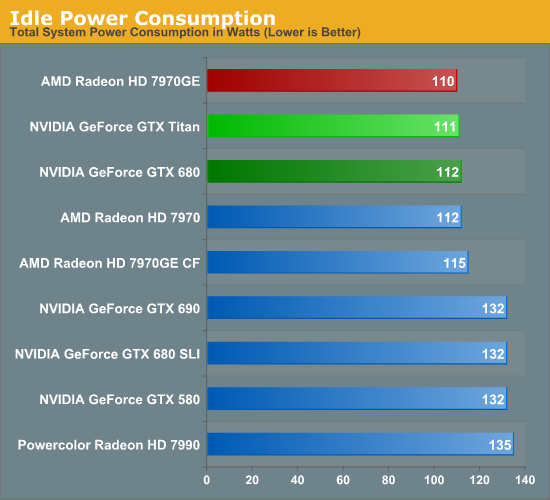
Starting as always with a look at power, there’s nothing particularly out of the ordinary here. AMD and NVIDIA have become very good at managing idle power through power gating and other techniques, and as a result idle power has come down by leaps and bounds over the years. At this point we still typically see some correlation between die size and idle power, but that’s a few watts at best. So at 111W at the wall, Titan is up there with the best cards.
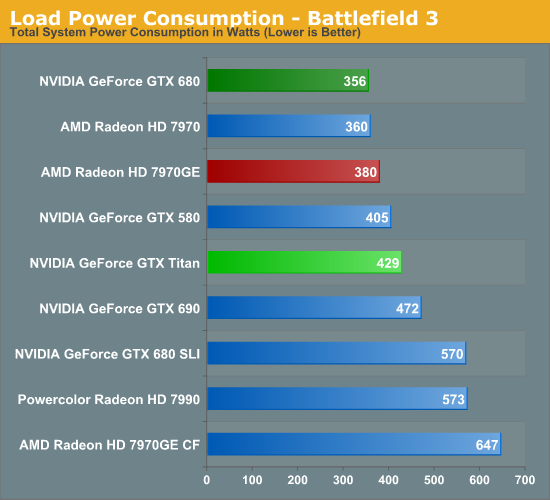
Moving on to our first load power measurement, as we’ve dropped Metro 2033 from our benchmark suite we’ve replaced it with Battlefield 3 as our game of choice for measuring peak gaming power consumption. BF3 is a difficult game to run, but overall it presents a rather typical power profile which of all the games in our benchmark suite makes it one of the best representatives.
In any case, as we can see Titan’s power consumption comes in below all of our multi-GPU configurations, but higher than any other single-GPU card. Titan’s 250W TDP is 55W higher than GTX 680’s 195W TDP, and with a 73W difference at the wall this isn’t too far off. A bit more surprising is that it’s drawing nearly 50W more than our 7970GE at the wall, given the fact that we know the 7970GE usually gets close to its TDP of 250W. At the same time since this is a live game benchmark, there are more factors than just the GPU in play. Generally speaking, the higher a card’s performance here, the harder the rest of the system will have to work to keep said card fed, which further increases power consumption at the wall.
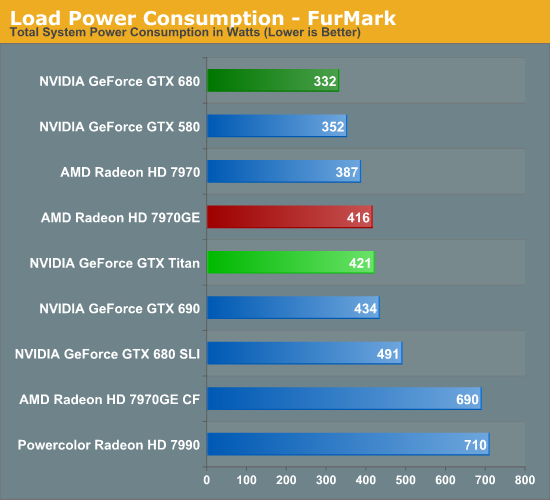
Moving to Furmark our results keep the same order, but the gap between the GTX 680 and Titan widens, while the gap between Titan and the 7970GE narrows. Titan and the 7970GE shouldn’t be too far apart from each other in most situations due to their similar TDPs (even if NVIDIA and AMD TDPs aren’t calculated in quite the same way), so in a pure GPU power consumption scenario this is what we would expect to see.
Titan for its part is the traditional big NVIDIA GPU, and while NVIDIA does what they can to keep it in check, at the end of the day it’s still going to be among the more power hungry cards in our collection. Power consumption itself isn’t generally a problem with these high end cards so long as a system has the means to cool it and doesn’t generate much noise in doing so.
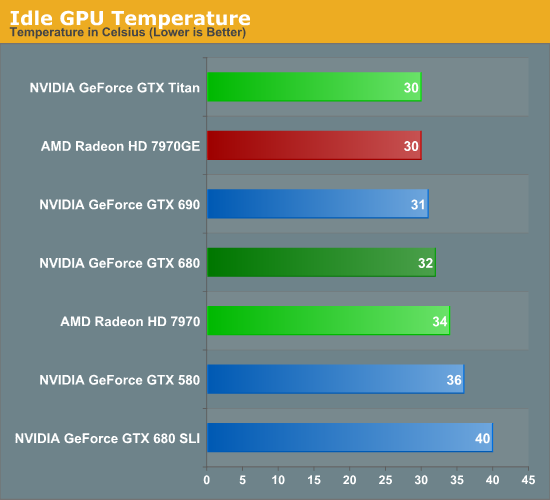
Moving on to temperatures, for a single card idle temperatures should be under 40C for anything with at least a decent cooler. Titan for its part is among the coolest at 30C; its large heatsink combined with its relatively low idle power consumption makes it easy to cool here.
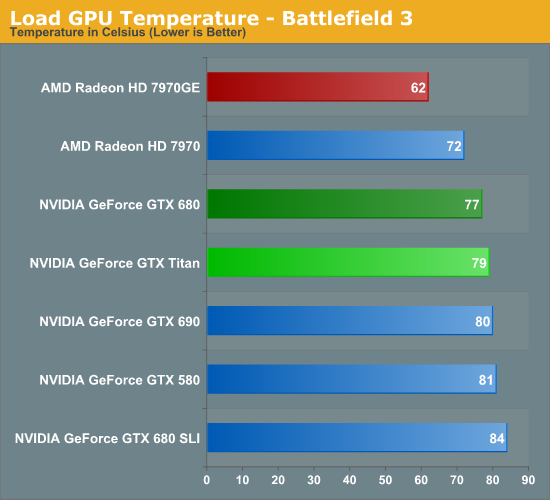
Because Titan’s boost mechanisms are now temperature based, Titan’s temperatures are going to naturally gravitate towards its default temperature target of 80C as the card raises and lowers clockspeeds to maximize performance while keeping temperatures at or under that level. As a result just about any heavy load is going to see Titan within a couple of degrees of 80C, which makes for some very predictable results.
Looking at our other cards, while the various NVIDIA cards are still close in performance the 7970GE ends up being quite a bit cooler due to its open air cooler. This is typical of what we see with good open air coolers, though with NVIDIA’s temperature based boost system I’m left wondering if perhaps those days are numbered. So long as 80C is a safe temperature, there’s little reason not to gravitate towards it with a system like NVIDIA’s, regardless of the cooler used.
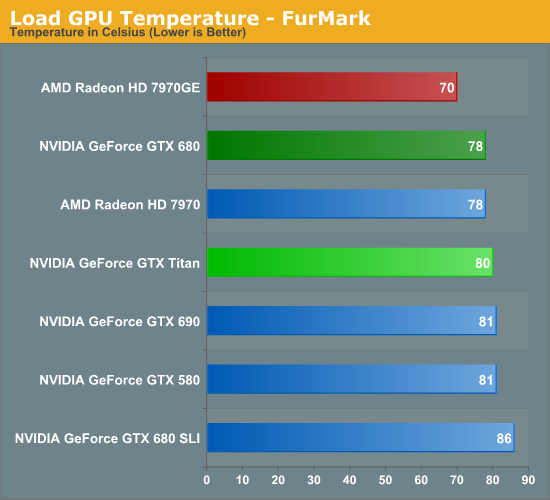
With Furmark we see everything pull closer together as Titan holds fast at 80C while most of the other cards, especially the Radeons, rise in temperature. At this point Titan is clearly cooler than a GTX 680 SLI, 2C warmer than a single GTX 680, and still a good 10C warmer than our 7970GE.

Just as with the GTX 690, one of the things NVIDIA focused on was construction choices and materials to reduce noise generated. So long as you can keep noise down, then for the most part power consumption and temperatures don’t matter.
Simply looking at idle shows that NVIDIA is capable of delivering on their claims. 37.8dB is the quietest actively cooled high-end card we’ve measured yet, besting even the luxury GTX 690, and the also well-constructed GTX 680. Though really with the loudest setup being all of 40.5dB, none of these setups is anywhere near loud at idle.
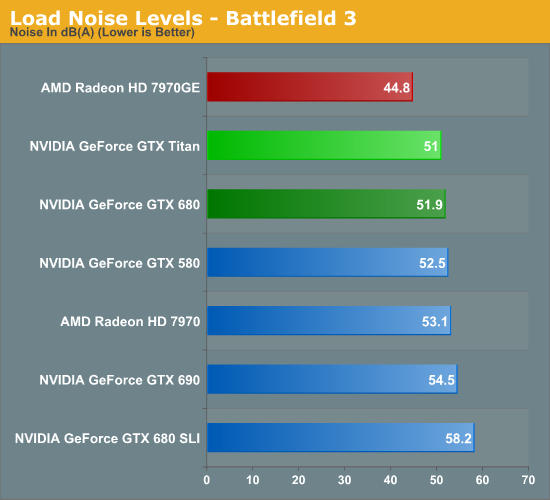
It’s with load noise that we finally see the full payoff of Titan’s build quality. At 51dB it’s only marginally quieter than the GTX 680, but as we recall from our earlier power data, Titan is drawing nearly 70W more than GTX 680 at the wall. In other words, despite the fact that Titan is drawing significantly more power than GTX 680, it’s still as quiet as or quieter than the aforementioned card. This coupled with Titan’s already high performance is Titan’s true power in NVIDIA’s eyes; it’s not just fast, but despite its speed and despite its TDP it’s as quiet as any other blower based card out there, allowing them to get away with things such as Tiki and tri-SLI systems with reasonable noise levels.
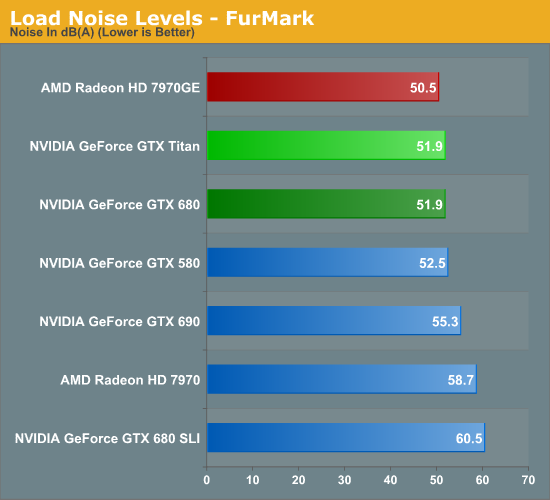
Much like what we saw with temperatures under Furmark, noise under Furmark has our single-GPU cards bunching up. Titan goes up just enough to tie GTX 680 in our pathological scenario, meanwhile our multi-GPU cards start shooting up well past Titan, while the 7970GE jumps up to just shy of Titan. This is a worst case scenario, but it’s a good example of how GPU Boost 2.0’s temperature functionality means that Titan quite literally keeps its cool and thereby keeps its noise in check.
Of course we would be remiss to point out that in all these scenarios the open air cooled 7970GE is still quieter, and in our gaming scenario by actually by quite a bit. Not that Titan is loud, but it doesn’t compare to the 7970GE. Ultimately we get to the age old debate between blowers and open air coolers; open air coolers are generally quieter, but blowers allow for more flexibility with products, and are more lenient with cases with poor airflow.
Ultimately Titan is a blower so that NVIDIA can do concept PCs like Tiki, which is something an open air cooler would never be suitable for. For DIY builders the benefits may not be as pronounced, but this is also why NVIDIA is focusing so heavily on boutique systems where the space difference really matters. Whereas realistically speaking, AMD’s best blower-capable card is the vanilla 7970, a less power hungry but also much less powerful card.










337 Comments
View All Comments
vps - Thursday, February 21, 2013 - link
For compute benchmark you might want to take a look at FAHBenchFAHBench is the official Folding@Home GPU benchmark. It measures the compute performance of GPUs for Folding@Home.
http://proteneer.com/blog/?page_id=1671
Some reference scores are here:
http://foldingforum.org/viewtopic.php?f=38&t=2...
Ryan Smith - Thursday, February 21, 2013 - link
FAHBench is primarily an OpenCL benchmark (there's a CUDA path, but it's effectively on its way out). It's on our list, and is one of the things we couldn't run due to the fact that OpenCL is not currently working on Titan.Hrel - Thursday, February 21, 2013 - link
PowerDirector still uses CUDAatlr - Thursday, February 21, 2013 - link
Not sure if this helps. I found CLBenchmark results of a Titan versus a 7970 here.http://clbenchmark.com/compare.jsp?config_0=144702...
atlr - Thursday, February 21, 2013 - link
Ville Timonen posted results running his own code on a Tesla K20 versus the usual suspects. Might be helpful to folks considering options for GPGPU computation.http://wili.cc/blog/gpgpu-faceoff.html
chizow - Thursday, February 21, 2013 - link
That's the first thing that comes to mind now when I think of Nvidia, which is a shame because that name used to be synonymous with Awesome. That's gone and replaced with a disdain for ridiculous levels of usury with their last two high-end product launches. I'm not going to be disingenuous and claim I'm going AMD, because the fact of the matter is, Nvidia products are still in a class of it's own for my usage needs, but I will certainly not be spending as much on Nvidia parts as I used to.Kepler has basically set back Nvidia's product stack back by half a generation, but my price:performance metrics will stay the same. Nvidia has their ultra-premium "Xtreme Edition" GPU this round, but that only came about as a result of AMD's ridiculous pricing and overall lackluster performance of the 7970 for a "flagship" card. Either way, I think it will be difficult for Nvidia to sustain this price point, as expectations just got higher at that $1K range.
@Ryan: I'm disappointed you didn't write a harsher commentary on the fact Nvidia is now charging 2x for the same class of GPU, pricing that has stayed true since 2006. Even the G80 Ultra didn't approach this $1K mark. Given how many times Nvidia has had to backpedal and apologize about the Ultra's pricing, you would think they would learn from their mistakes. I guess not, I hope they are prepared to deal with the long-term ramifications, backlash, and loss of goodwill stemming from this pricing decision.
CeriseCogburn - Thursday, February 21, 2013 - link
7.1 billion transistors and 6G of ram.I for one am sick of you people constantly whining.
If we check the whine log from the ATI32 days you were doing it then, too.
It's all you people do. Every time, all the time.
chizow - Friday, February 22, 2013 - link
And all you do is post inane, barely intelligible nonsense in defense of Nvidia. If you check your "whine logs" you'll see I've done my fair share of defending Nvidia, but I can't and won't give them a pass for what they've done with Kepler. AMD started it for sure with the terribad price:performance of Tahiti, but Nvidia has taken it to a new level of greed.And for all the idiots who are going to reply "herr dueerr Nvidai need make money not a charity derrr", my advanced reply is that Nvidia has made money in all but 2-3 quarters since 2006 without selling a single $1K desktop GPU. In fact, they enjoyed record profits, margin and revenue on the back of a $250 GPU, the 8800GT in 2007-2008.
CeriseCogburn - Saturday, February 23, 2013 - link
Nope, you are the crying whining baby who says the same thing in 100 different posts here, and has no clue what "the economy" of "the world" has been doing for the past several years.Whatever.
Please go cry about all the other computer part prices that are doing the same thing.
CeriseCogburn - Saturday, February 23, 2013 - link
I mean you idiots want the same price for more perf over a DECADE. Meanwhile, the rest of the worlds pricing has DOUBLED.Now, computer prices used to drop across the board, but they just aren't doing it anymore, and IDIOTS like yourself continue on your stupid frikkin rants, ignoring the world itself, not to mention the LACK of production in that world for the GPU's you whine about. It's really funny how stupid you are.